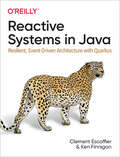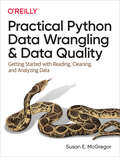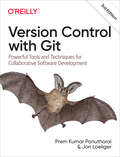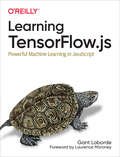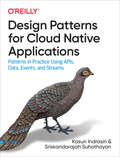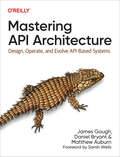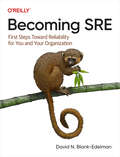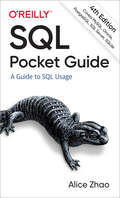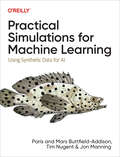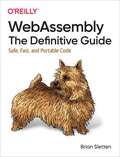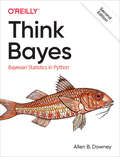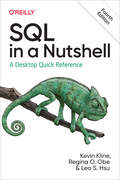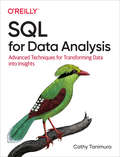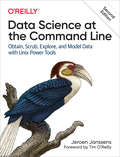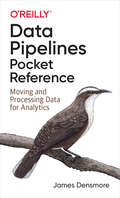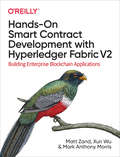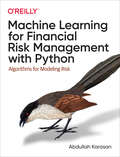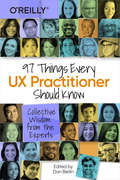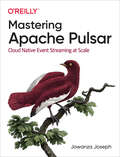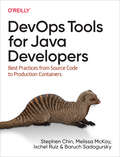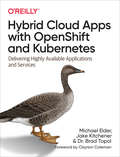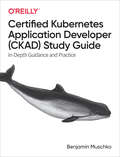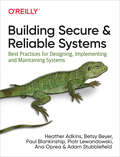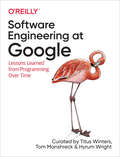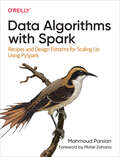- Table View
- List View
Reactive Systems in Java
by Ken Finnigan Clement EscoffierReactive systems and event-driven architecture are becoming indispensable to application design, and companies are taking note. Reactive systems ensure that applications are responsive, resilient, and elastic no matter what failures or errors may be occurring, while event-driven architecture offers a flexible and composable option for distributed systems. This practical book helps Java developers bring these approaches together using Quarkus 2.x, the Kubernetes-native Java framework.Clement Escoffier and Ken Finnigan show you how to take advantage of event-driven and reactive principles to build robust distributed systems, reducing latency and increasing throughput, particularly in microservices and serverless applications. You'll also get a foundation in Quarkus to help you create true Kubernetes-native applications for the cloud.Understand the fundamentals of reactive systems and event-driven architectureLearn how to use Quarkus to build reactive applicationsCombine Quarkus with Apache Kafka or AMQP to build reactive systemsDevelop microservices that utilize messages with Quarkus for use in event-driven architecturesLearn how to integrate external messaging systems, such as Apache Kafka, with QuarkusBuild applications with Quarkus using reactive systems and reactive programming concepts
Practical Python Data Wrangling and Data Quality: Getting Started With Reading, Cleaning, And Analyzing Data
by Susan E. McGregorThe world around us is full of data that holds unique insights and valuable stories, and this book will help you uncover them. Whether you already work with data or want to learn more about its possibilities, the examples and techniques in this practical book will help you more easily clean, evaluate, and analyze data so that you can generate meaningful insights and compelling visualizations.Complementing foundational concepts with expert advice, author Susan E. McGregor provides the resources you need to extract, evaluate, and analyze a wide variety of data sources and formats, along with the tools to communicate your findings effectively. This book delivers a methodical, jargon-free way for data practitioners at any level, from true novices to seasoned professionals, to harness the power of data.Use Python 3.8+ to read, write, and transform data from a variety of sourcesUnderstand and use programming basics in Python to wrangle data at scaleOrganize, document, and structure your code using best practicesCollect data from structured data files, web pages, and APIsPerform basic statistical analyses to make meaning from datasetsVisualize and present data in clear and compelling ways
Version Control with Git
by Jon Loeliger Prem Kumar PonuthoraiTrack, branch, merge, and manage code revisions with Git, the free and open source distributed version control system. Through a series of step-by-step tutorials, this practical guide quickly takes you from Git fundamentals to advanced techniques, and provides friendly yet rigorous advice for navigating Git's many functions. You'll learn how to work with everything from small to very large projects with speed and efficiency.In this third edition, authors Prem Kumar Ponuthorai and Jon Loeliger break down Git concepts using a modular approach. You'll start with the basics and fundamental philosophy of Git, followed by intermediate commands to help you efficiently supplement your daily development workflow. Finally, you'll learn advanced Git commands and concepts to understand how Git works under the hood.Learn how to use Git for real-world development scenariosGain insight into Git's common use cases, initial tasks, and basic functionsUse the system for distributed version controlLearn how to manage merges, conflicts, patches, and diffsApply advanced techniques such as rebasing, hooks, and ways to handle submodules
Learning TensorFlow.js: Powerful Machine Learning In Javascript
by Gant LabordeGiven the demand for AI and the ubiquity of JavaScript, TensorFlow.js was inevitable. With this Google framework, seasoned AI veterans and web developers alike can help propel the future of AI-driven websites. In this guide, author Gant Laborde--Google Developer Expert in machine learningand the web--provides a hands-on end-to-end approach to TensorFlow.js fundamentals for a broad technical audience that includes data scientists, engineers, web developers, students, and researchers.You'll begin by working through some basic examples in TensorFlow.js before diving deeper into neural network architectures, DataFrames, TensorFlow Hub, model conversion, transfer learning, and more. Once you finish this book, you'll know how to build and deploy production-readydeep learning systems with TensorFlow.js.Explore tensors, the most fundamental structure of machine learningConvert data into tensors and back with a real-world exampleCombine AI with the web using TensorFlow.jsUse resources to convert, train, and manage machine learning dataBuild and train your own training models from scratch
Design Patterns for Cloud Native Applications
by Kasun Indrasiri Sriskandarajah SuhothayanWith the immense cost savings and scalability the cloud provides, the rationale for building cloud native applications is no longer in question. The real issue is how. With this practical guide, developers will learn about the most commonly used design patterns for building cloud native applications using APIs, data, events, and streams in both greenfield and brownfield development.You'll learn how to incrementally design, develop, and deploy large and effective cloud native applications that you can manage and maintain at scale with minimal cost, time, and effort. Authors Kasun Indrasiri and Sriskandarajah Suhothayan highlight use cases that effectively demonstrate the challenges you might encounter at each step.Learn the fundamentals of cloud native applicationsExplore key cloud native communication, connectivity, and composition patternsLearn decentralized data management techniquesUse event-driven architecture to build distributed and scalable cloud native applicationsExplore the most commonly used patterns for API management and consumptionExamine some of the tools and technologies you'll need for building cloud native systems
Mastering API Architecture
by James Gough Daniel Bryant Matthew AuburnMost organizations with a web presence build and operate APIs; the doorway for customers to interact with the company's services. Designing, building, and managing these critical programs affect everyone in the organization, from engineers and product owners to C-suite executives. But the real challenge for developers and solution architects is creating an API platform from the ground up.With this practical book, you'll learn strategies for building and testing REST APIs that use API gateways to combine offerings at the microservice level. Authors James Gough, Daniel Bryant, and Matthew Auburn demonstrate how simple additions to this infrastructure can help engineers and organizations migrate to the cloud; and open the opportunity to connect internal services using technologies like a service mesh.Learn API fundamentals and architectural patterns for building an API platformUse practical examples to understand how to design, build, and test API-based systemsDeploy, operate, and configure key components of an API platformUse API gateways and service meshes appropriately, based on case studiesUnderstand core security and common vulnerabilities in API architectureSecure data and APIs using threat modeling and technologies like OAuth2 and TLSLearn how to evolve existing systems toward API- and cloud-based architectures
Becoming SRE
by David N. Blank-EdelmanDo you wish the existing books on site reliability engineering started at the beginning? Do you wish someone would walk you through how to become an SRE, how to think like an SRE, or how to build and grow a successful SRE function in your organization? Becoming SRE addresses all of these needs and more with three interconnected sections: the essential groundwork for understanding SRE and SRE culture, advice for individuals on becoming an SRE, and guidance for organizations on creating and developing a thriving SRE practice. Acting as your personal and personable guide, author David Blank-Edelman takes you through subjects like: SRE mindset, SRE culture, and SRE advocacyWhat you need to get started and hired in SRE and what the job will be like when you get thereWhat you need to bring SRE into an organization and what is required for a good organizational fit so it can thrive thereHow to work with your business folks and management around SREHow SRE can grow and mature in an organization over time Ready to become an SRE or introduce SRE into your organization? This book is here to help.
SQL Pocket Guide: A Guide To Sql Usage
by Alice ZhaoIf you use SQL in your day-to-day work as a data analyst, data scientist, or data engineer, this popular pocket guide is your ideal on-the-job reference. You'll find many examples that address the language's complexities, along with key aspects of SQL used in Microsoft SQL Server, MySQL, Oracle Database, PostgreSQL, and SQLite.In this updated edition, author Alice Zhao describes how these database management systems implement SQL syntax for both querying and making changes to a database. You'll find details on data types and conversions, regular expression syntax, window functions, pivoting and unpivoting, and more.Quickly look up how to perform specific tasks using SQLApply the book's syntax examples to your own queriesUpdate SQL queries to work in five different database management systems NEW: Connect Python and R to a relational databaseNEW: Look up frequently asked SQL questions in the "How Do I?" chapter
Practical Simulations for Machine Learning
by Paris Buttfield-Addison Tim Nugent Jon Manning Mars Buttfield-AddisonSimulation and synthesis are core parts of the future of AI and machine learning. Consider: programmers, data scientists, and machine learning engineers can create the brain of a self-driving car without the car. Rather than use information from the real world, you can synthesize artificial data using simulations to train traditional machine learning models.That’s just the beginning.With this practical book, you’ll explore the possibilities of simulation- and synthesis-based machine learning and AI, concentrating on deep reinforcement learning and imitation learning techniques. AI and ML are increasingly data driven, and simulations are a powerful, engaging way to unlock their full potential.You'll learn how to:Design an approach for solving ML and AI problems using simulations with the Unity engineUse a game engine to synthesize images for use as training dataCreate simulation environments designed for training deep reinforcement learning and imitation learning modelsUse and apply efficient general-purpose algorithms for simulation-based ML, such as proximal policy optimizationTrain a variety of ML models using different approachesEnable ML tools to work with industry-standard game development tools, using PyTorch, and the Unity ML-Agents and Perception Toolkits
WebAssembly: Safe, Fast, And Portable Code
by Brian SlettenWebAssembly: The Definitive Guide is a thorough and accessible introduction to one of the most transformative technologies hitting our industry. What started as a way to use languages other than JavaScript in the browser has evolved into a comprehensive path toward portability, performance, increased security, and greater code reuse across an impressive collection of deployment targets.Author Brian Sletten introduces elements of this technology incrementally while building to several concrete, code-driven examples of practical, cutting-edge WebAssembly uses. Whether you work with enterprise software or embedded systems, or in entertainment, scientific computing, or startup environments, you'll learn how WebAssembly can have a positive impact on the way you develop software.Use WebAssembly to increase code portability across platformsReuse more of your software assets in a wider number of deployment targetsLearn how WebAssembly increases protection against prominent security attacksUse WebAssembly to deploy legacy code in web environmentsIncrease your user base across languages and development environmentsIntegrate JavaScript code with other languages and environments to improve performance, security, and productivityLearn how WebAssembly will affect your career as software developer
Think Bayes: Bayesian Statistics In Python
by Allen B. DowneyIf you know how to program, you're ready to tackle Bayesian statistics. With this book, you'll learn how to solve statistical problems with Python code instead of mathematical formulas, using discrete probability distributions rather than continuous mathematics. Once you get the math out of the way, the Bayesian fundamentals will become clearer and you'll begin to apply these techniques to real-world problems.Bayesian statistical methods are becoming more common and more important, but there aren't many resources available to help beginners. Based on undergraduate classes taught by author Allen B. Downey, this book's computational approach helps you get a solid start.Use your programming skills to learn and understand Bayesian statisticsWork with problems involving estimation, prediction, decision analysis, evidence, and Bayesian hypothesis testingGet started with simple examples, using coins, dice, and a bowl of cookiesLearn computational methods for solving real-world problems
SQL in a Nutshell
by Kevin Kline Regina O. Obe Leo S. HsuFor programmers, analysts, and database administrators, this Nutshell guide is the essential reference for the SQL language used in today's most popular database products. This new fourth edition clearly documents SQL commands according to the latest ANSI/ISO standard and details how those commands are implemented in Microsoft SQL Server 2019 and Oracle 19c, as well as in the MySQL 8, MariaDB 10.5, and PostgreSQL 14 open source database products.You'll also get a concise overview of the relational database management system (RDBMS) model and a clear-cut explanation of foundational RDBMS concepts--all packed into a succinct, comprehensive, and easy-to-use format.Sections include:Background on the relational database model, including current and previous SQL standardsFundamental concepts necessary for understanding relational databases and SQL commandsAn alphabetical command reference to SQL statements, according to the SQL:2016 ANSI standardThe implementation of each command by MySQL, Oracle, PostgreSQL, and SQL ServerAn alphabetical reference of the ANSI SQL:2016 functions and constructs as well as the vendor implementationsPlatform-specific functions unique to each implementation
SQL for Data Analysis: Advanced Techniques For Transforming Data Into Insights
by Cathy TanimuraWith the explosion of data, computing power, and cloud data warehouses, SQL has become an even more indispensable tool for the savvy analyst or data scientist. This practical book reveals new and hidden ways to improve your SQL skills, solve problems, and make the most of SQL as part of your workflow.You'll learn how to use both common and exotic SQL functions such as joins, window functions, subqueries, and regular expressions in new, innovative ways--as well as how to combine SQL techniques to accomplish your goals faster, with understandable code. If you work with SQL databases, this is a must-have reference.Learn the key steps for preparing your data for analysisPerform time series analysis using SQL's date and time manipulationsUse cohort analysis to investigate how groups change over timeUse SQL's powerful functions and operators for text analysisDetect outliers in your data and replace them with alternate valuesEstablish causality using experiment analysis, also known as A/B testing
Data Science at the Command Line
by Jeroen JanssensThis thoroughly revised guide demonstrates how the flexibility of the command line can help you become a more efficient and productive data scientist. You'll learn how to combine small yet powerful command-line tools to quickly obtain, scrub, explore, and model your data. To get you started, author Jeroen Janssens provides a Docker image packed with over 80 tools--useful whether you work with Windows, macOS, or Linux.You'll quickly discover why the command line is an agile, scalable, and extensible technology. Even if you're comfortable processing data with Python or R, you'll learn how to greatly improve your data science workflow by leveraging the command line's power. This book is ideal for data scientists, analysts, and engineers; software and machine learning engineers; and system administrators.Obtain data from websites, APIs, databases, and spreadsheetsPerform scrub operations on text, CSV, HTM, XML, and JSON filesExplore data, compute descriptive statistics, and create visualizationsManage your data science workflowCreate reusable command-line tools from one-liners and existing Python or R codeParallelize and distribute data-intensive pipelinesModel data with dimensionality reduction, clustering, regression, and classification algorithms
Data Pipelines Pocket Reference: Moving And Processing Data For Analytics
by James DensmoreData pipelines are the foundation for success in data analytics. Moving data from numerous diverse sources and transforming it to provide context is the difference between having data and actually gaining value from it. This pocket reference defines data pipelines and explains how they work in today's modern data stack.You'll learn common considerations and key decision points when implementing pipelines, such as batch versus streaming data ingestion and build versus buy. This book addresses the most common decisions made by data professionals and discusses foundational concepts that apply to open source frameworks, commercial products, and homegrown solutions.You'll learn:What a data pipeline is and how it worksHow data is moved and processed on modern data infrastructure, including cloud platformsCommon tools and products used by data engineers to build pipelinesHow pipelines support analytics and reporting needsConsiderations for pipeline maintenance, testing, and alerting
Hands-On Smart Contract Development with Hyperledger Fabric V2: Building Enterprise Blockchain Applications
by Xun Brian Wu Matt Zand Mark Anthony MorrisBlockchain technology continues to disrupt a wide variety of organizations, from small businesses to the Fortune 500. Today hundreds of blockchain networks are in production, including many built with Hyperledger Fabric. This practical guide shows developers how the latest version of this blockchain infrastructure provides an ideal foundation for developing enterprise blockchain applications or solutions.Authors Matt Zand, Xun Wu, and Mark Anthony Morris demonstrate how the versatile design of Hyperledger Fabric 2.0 satisfies a broad range of industry use cases. Developers with or without previous Hyperledger experience will discover why no other distributed ledger technology framework enjoys such wide adoption by cloud service providers such as Amazon, Alibaba, IBM, Google, and Oracle.Walk through the architecture and components of Hyperledger Fabric 2.0Migrate your current Hyperledger Fabric projects to version 2.0Develop blockchain applications on the Hyperledger platform with Node.jsDeploy and integrate Hyperledger on Amazon Managed Blockchain, IBM Cloud, and Oracle CloudDevelop blockchain applications with Hyperledger Aries, Avalon, Besu, and GridBuild end-to-end blockchain supply chain applications with Hyperledger
Machine Learning for Financial Risk Management with Python: Algorithms For Modeling Risk
by Abdullah KarasanFinancial risk management is quickly evolving with the help of artificial intelligence. With this practical book, developers, programmers, engineers, financial analysts, risk analysts, and quantitative and algorithmic analysts will examine Python-based machine learning and deep learning models for assessing financial risk. Building hands-on AI-based financial modeling skills, you'll learn how to replace traditional financial risk models with ML models.Author Abdullah Karasan helps you explore the theory behind financial risk modeling before diving into practical ways of employing ML models in modeling financial risk using Python. With this book, you will:Review classical time series applications and compare them with deep learning modelsExplore volatility modeling to measure degrees of risk, using support vector regression, neural networks, and deep learningImprove market risk models (VaR and ES) using ML techniques and including liquidity dimensionDevelop a credit risk analysis using clustering and Bayesian approachesCapture different aspects of liquidity risk with a Gaussian mixture model and Copula modelUse machine learning models for fraud detectionPredict stock price crash and identify its determinants using machine learning models
97 Things Every UX Practitioner Should Know
by Daniel BerlinTap into the wisdom of experts to learn what every UX practitioner needs to know. With 97 short and extremely useful articles, you'll discover new approaches to old problems, pick up road-tested best practices, and hone your skills through sound advice.Working in UX involves much more than just creating user interfaces. UX teams struggle with understanding what's important, which practices they should know deeply, and what approaches aren't helpful at all. With these 97 concise articles, editor Dan Berlin presents a wealth of advice and knowledge from experts who have practiced UX throughout their careers.Bring Themes to Exploratory Research--Shanti KanhaiDesign for Content First--Marli MesibovDesign for Universal Usability--Ann Chadwick-DiasBe Wrong on Purpose--Skyler Ray TaylorDiverse Participant Recruiting Is Critical to Authentic User Research--Megan CamposPut On Your InfoSec Hat to Improve Your Designs--Julie MeridianBoost Your Emotional Intelligence to Move from Good to Great UX--Priyama Barua
Mastering Apache Pulsar: Cloud Native Event Streaming At Scale
by Jowanza JosephEvery enterprise application creates data, including log messages, metrics, user activity, and outgoing messages. Learning how to move these items is almost as important as the data itself. If you're an application architect, developer, or production engineer new to Apache Pulsar, this practical guide shows you how to use this open source event streaming platform to handle real-time data feeds.Jowanza Joseph, staff software engineer at Finicity, explains how to deploy production Pulsar clusters, write reliable event streaming applications, and build scalable real-time data pipelines with this platform. Through detailed examples, you'll learn Pulsar's design principles, reliability guarantees, key APIs, and architecture details, including the replication protocol, the load manager, and the storage layer.This book helps you:Understand how event streaming fits in the big data ecosystemExplore Pulsar producers, consumers, and readers for writing and reading eventsBuild scalable data pipelines by connecting Pulsar with external systemsSimplify event-streaming application building with Pulsar FunctionsManage Pulsar to perform monitoring, tuning, and maintenance tasksUse Pulsar's operational measurements to secure a production clusterProcess event streams using Flink and query event streams using Presto
DevOps Tools for Java Developers
by Stephen Chin Melissa McKay Ixchel Ruiz Baruch SadogurskyWith the rise of DevOps, low-cost cloud computing, and container technologies, the way Java developers approach development today has changed dramatically. This practical guide helps you take advantage of microservices, serverless, and cloud native technologies using the latest DevOps techniques to simplify your build process and create hyperproductive teams.Stephen Chin, Melissa McKay, Ixchel Ruiz, and Baruch Sadogursky from JFrog help you evaluate an array of options. The list includes source control with Git, build declaration with Maven and Gradle, CI/CD with CircleCI, package management with Artifactory, containerization with Docker and Kubernetes, and much more. Whether you're building applications with Jakarta EE, Spring Boot, Dropwizard, MicroProfile, Micronaut, or Quarkus, this comprehensive guide has you covered.Explore software lifecycle best practicesUse DevSecOps methodologies to facilitate software development and deliveryUnderstand the business value of DevSecOps best practicesManage and secure software dependenciesDevelop and deploy applications using containers and cloud native technologiesManage and administrate source control repositories and development processesUse automation to set up and administer build pipelinesIdentify common deployment patterns and antipatternsMaintain and monitor software after deployment
Hybrid Cloud Apps with OpenShift and Kubernetes
by Michael Elder Jake Kitchener Dr Brad TopolSelling your CTO on the merits of OpenShift and Kubernetes is only the beginning. To operate and scale OpenShift, you also need to know how to manage and expose resources to application teams and continuously deliver changes to the applications running in these environments. With this practical book, new and experienced developers and operators will learn specific techniques for operationalizing OpenShift and Kubernetes in the enterprise.Industry experts Michael Elder, Jake Kitchener, and Brad Topol show you how to run OpenShift and Kubernetes in production and deliver your applications to a highly available, secure, and scalable platform. You'll learn how to build a strong foundation in advanced cluster operational topics, such as tenancy management, scheduling and capacity management, cost management, continuous delivery, and more.Examine the fundamental concepts of Kubernetes architectureGet different Kubernetes and OpenShift environments up and runningDive into advanced resource management topics, including capacity planningLearn how to support high availability inside a single clusterUse production-level approaches for continuous delivery and code promotion across clustersExplore hybrid cloud use cases, including multicluster provisioning, upgrading, and policy supportDevise and deliver disaster recovery strategies
Certified Kubernetes Application Developer (CKAD) Study Guide: In-depth Guidance And Practice
by Benjamin MuschkoDevelopers with the ability to operate, troubleshoot, and monitor applications in Kubernetes are in high demand today. To meet this need, the Cloud Native Computing Foundation created a certification exam to establish a developer's credibility and value in the job market to work in a Kubernetes environment.The Certified Kubernetes Application Developer (CKAD) exam is different from the typical multiple-choice format of other certifications. Instead, the CKAD is a performance-based exam that requires deep knowledge of the tasks under immense time pressure.This study guide walks you through all the topics you need to fully prepare for the exam. Author Benjamin Muschko also shares his personal experience with preparing for all aspects of the exam.Learn when and how to apply Kubernetes concepts to manage an applicationUnderstand the objectives, abilities, tips, and tricks needed to pass the CKAD examExplore the ins and outs of the kubectl command-line toolDemonstrate competency for performing the responsibilities of a Kubernetes application developerSolve real-world Kubernetes problems in a hands-on command-line environmentNavigate and solve questions during the CKAD exam
Building Secure and Reliable Systems: Best Practices for Designing, Implementing, and Maintaining Systems
by Heather Adkins Betsy Beyer Paul Blankinship Piotr Lewandowski Ana Oprea Adam StubblefieldCan a system be considered truly reliable if it isn't fundamentally secure? Or can it be considered secure if it's unreliable? Security is crucial to the design and operation of scalable systems in production, as it plays an important part in product quality, performance, and availability. In this book, experts from Google share best practices to help your organization design scalable and reliable systems that are fundamentally secure. <P><P>Two previous O’Reilly books from Google—Site Reliability Engineering and The Site Reliability Workbook—demonstrated how and why a commitment to the entire service lifecycle enables organizations to successfully build, deploy, monitor, and maintain software systems. In this latest guide, the authors offer insights into system design, implementation, and maintenance from practitioners who specialize in security and reliability. They also discuss how building and adopting their recommended best practices requires a culture that’s supportive of such change. <P><P>You’ll learn about secure and reliable systems through: <P><P>Design strategies <P><P>Recommendations for coding, testing, and debugging practices <P><P>Strategies to prepare for, respond to, and recover from incidents <P><P>Cultural best practices that help teams across your organization collaborate effectively
Software Engineering at Google: Lessons Learned from Programming Over Time
by Titus Winters Tom Manshreck Hyrum WrightToday, software engineers need to know not only how to program effectively but also how to develop proper engineering practices to make their codebase sustainable and healthy. This book emphasizes this difference between programming and software engineering. <p><p>How can software engineers manage a living codebase that evolves and responds to changing requirements and demands over the length of its life? Based on their experience at Google, software engineers Titus Winters and Hyrum Wright, along with technical writer Tom Manshreck, present a candid and insightful look at how some of the world’s leading practitioners construct and maintain software. This book covers Google’s unique engineering culture, processes, and tools and how these aspects contribute to the effectiveness of an engineering organization. <p><p>You’ll explore three fundamental principles that software organizations should keep in mind when designing, architecting, writing, and maintaining code: <li>How time affects the sustainability of software and how to make your code resilient over time <li>How scale affects the viability of software practices within an engineering organization <li>What trade-offs a typical engineer needs to make when evaluating design and development decisions
Data Algorithms with Spark: Recipes For Scaling Up With Hadoop And Spark
by Mahmoud ParsianApache Spark's speed, ease of use, sophisticated analytics, and multilanguage support makes practical knowledge of this cluster-computing framework a required skill for data engineers and data scientists. With this hands-on guide, anyone looking for an introduction to Spark will learn practical algorithms and examples using PySpark.In each chapter, author Mahmoud Parsian shows you how to solve a data problem with a set of Spark transformations and algorithms. You'll learn how to tackle problems involving ETL, design patterns, machine learning algorithms, data partitioning, and genomics analysis. Each detailed recipe includes PySpark algorithms using the PySpark driver and shell script.With this book, you will:Learn how to select Spark transformations for optimized solutionsExplore powerful transformations and reductions including reduceByKey(), combineByKey(), and mapPartitions()Understand data partitioning for optimized queriesBuild and apply a model using PySpark design patternsApply motif-finding algorithms to graph dataAnalyze graph data by using the GraphFrames APIApply PySpark algorithms to clinical and genomics dataLearn how to use and apply feature engineering in ML algorithmsUnderstand and use practical and pragmatic data design patterns
